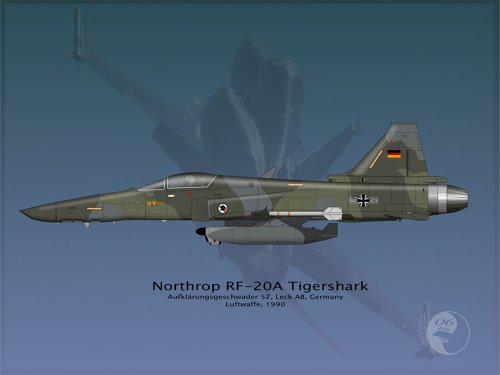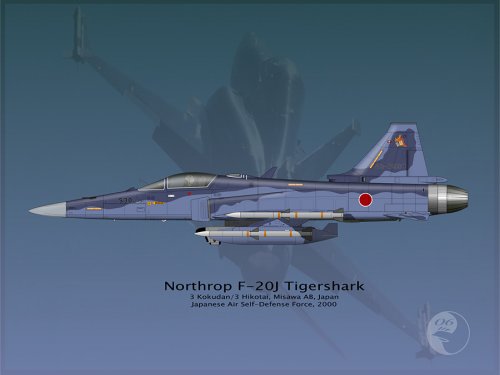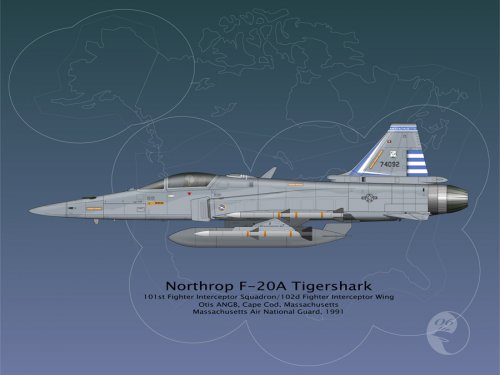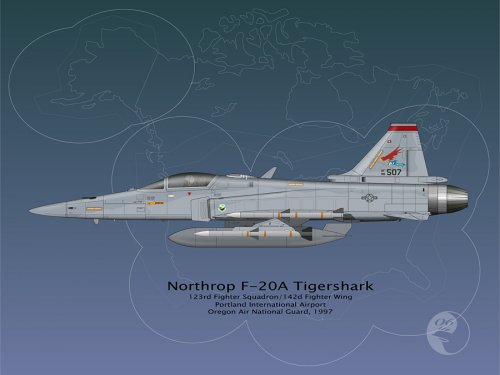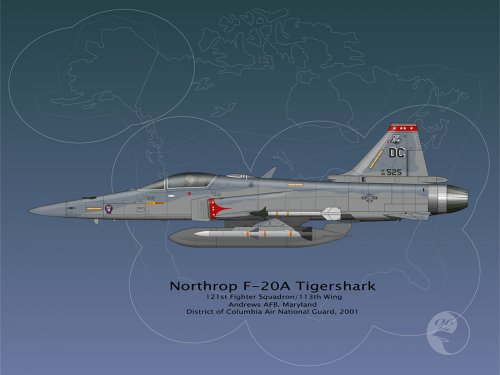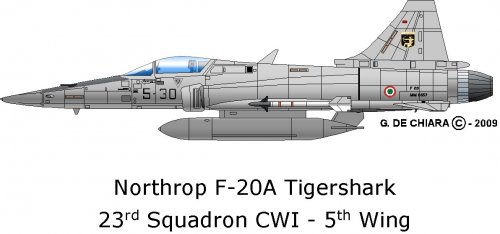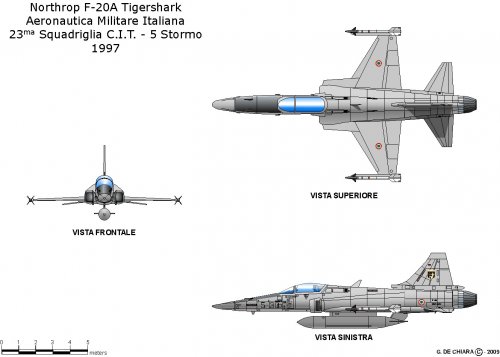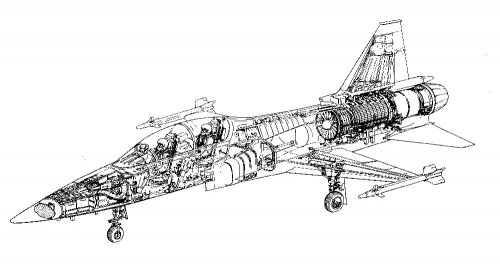Sentinel Chicken
American 71 Heavy, contact departure 126.47
One of my favorite jet fighters is the Northrop F-20 Tigershark. Originally conceived as the ultimate development of the F-5 (which started in the late 1950s as the F-5A Freedom Fighter, transformed in the early 1970s into the improved F-5E Tiger II and also shares a lineage with the first supersonic trainer in the world, the T-38 Talon), it was small, light, but powerful with a GE F404 engine replacing the two small J85s on previous marks. It was like the high performance roadster of fighter jets and to me always cool thanks to its rakish looks and cool name "Tigershark".
For a good concise history of what started out as the F-5G and later became the F-20 Tigershark, I recommend Joe Baugher's article here.
So suppose the F-20 Tigershark went into production in the mid-1980s and was procured large-scale for the US Air National Guard to fly the air defense mission? (This ultimately fell to what some believe was the less-suitable F-16A ADF variant- Air Defense Fighter) What would we have seen?

^Of course we have to lead off with a Texas ANG unit, what was in the 1980s and 1990s designated the 147th FIG (now as the 147th Fighter Group, operate F-16s out of Ellington Field south of Houston). Technically full-color markings were reserved for the commander's aircraft, but this illustration blends those flamboyant markings with otherwise standard unit markings. The 147th FIG moved to EFD in 1956 and has long been an ANG interceptor unit, operating F-80Cs, F-86D/Ls, F-102As (when George W. Bush served with the unit), F-101B/Fs, and F-4C/Ds. Many pilots in the ANG who would fly the F-101 and F-102 trained with the 147th FIG before moving on to their assigned units. The unit is heavily tasked in flying anti-drug missions to this day.
I've added a few features to delineate these as hypothetical production Tigersharks- primarily the air-refuelling receptacle on the spine aft of the cockpit and the distinctive AIFF (advanced identification friend or foe) antenna array just forward of the windscreen.
Camouflage is based on what the F-16s wore when they entered USAF service in the 1980s.

^This Oregon ANG unit has some of the coolest squadron markings around (today they're actually an F-16 unit based in Klamath Falls, Oregon, at Kingsley Field). In the 1980s they were established there as the 114th TFTS with the task of training ANG pilots to fly the air defense mission. Initially using F-4Cs, the 114th TFTS (today redesignated as the 114th Fighter Squadron) transitioned to the F-16A ADF 1988-1989. So had the F-20A entered service with the Air National Guard, this unit would have been one of the first operators of the Tigershark.

^Now here's a fantasy of a fantasy- there were no official proposals for a two-seat combat trainer version of the F-20 Tigershark, given that its predecessors the F-5A and F-5E both had fully combat capable two seaters (the F-5B and F-5F respectively), it was only natural to envision an F-20B variant. This illustration shows the hypothetical twin seater in the colors of the 162nd TFG of the Arizona ANG which in reality has served as the primary training unit for ANG F-16 pilots at its base at TUS. The 162nd trained ANG pilots in the F-100 and then the A-7D before transitioning to the F-16 1986-1991. Had the Tigershark entered service, the 162nd (today redesignated as the 162nd Fighter Group) would have been the RTU for the Guard (replacement training unit).
Markings have the Arizona flag in the tail flash with "Arizona" in script below. This one has a different variant of Sidewinder missile on the wingtip stations and an AN/ALQ-119 ECM pod on the centerline station.

^In 1987 the 184th TFG of the Kansas ANG was selected to be a second training unit for the ANG F-16 force, the "Jayhawks" having previously been the ANG's F-105D training unit in the 1970s and the ANG's F-4 training unit in the 1980s, operating F-4Ds. The unit transitioned to the F-16 from 1987-1990 and had the Tigershark been ordered for the ANG, it's likely it would have been one of the RTUs for the Guard's Tigershark force. This one wears low-vis markings on the tail of the flamboyant Jayhawks markings but the service markings and stencils are now a lower-vis version of what the previous three F-20s above are wearing- about this time was when the F-16 force was transitioning to gray service/warning markings.
This F-20B is shown with AIM-7 Sparrow medium range BVR (beyond visual range) missiles underwing- that was something that the actual Tigershark prototypes were capable of, firing BVR missiles while at the time, the F-16 could not do so operationally. Some believe the F-16A ADF/Sparrow integration went less than smoothly and cost more than it should have and that the F-20 would have been a superior choice for air defense.
Enjoy! More Tigersharks coming, both ANG and other countries that might have operated the F-20A/B!
For a good concise history of what started out as the F-5G and later became the F-20 Tigershark, I recommend Joe Baugher's article here.
So suppose the F-20 Tigershark went into production in the mid-1980s and was procured large-scale for the US Air National Guard to fly the air defense mission? (This ultimately fell to what some believe was the less-suitable F-16A ADF variant- Air Defense Fighter) What would we have seen?

^Of course we have to lead off with a Texas ANG unit, what was in the 1980s and 1990s designated the 147th FIG (now as the 147th Fighter Group, operate F-16s out of Ellington Field south of Houston). Technically full-color markings were reserved for the commander's aircraft, but this illustration blends those flamboyant markings with otherwise standard unit markings. The 147th FIG moved to EFD in 1956 and has long been an ANG interceptor unit, operating F-80Cs, F-86D/Ls, F-102As (when George W. Bush served with the unit), F-101B/Fs, and F-4C/Ds. Many pilots in the ANG who would fly the F-101 and F-102 trained with the 147th FIG before moving on to their assigned units. The unit is heavily tasked in flying anti-drug missions to this day.
I've added a few features to delineate these as hypothetical production Tigersharks- primarily the air-refuelling receptacle on the spine aft of the cockpit and the distinctive AIFF (advanced identification friend or foe) antenna array just forward of the windscreen.
Camouflage is based on what the F-16s wore when they entered USAF service in the 1980s.

^This Oregon ANG unit has some of the coolest squadron markings around (today they're actually an F-16 unit based in Klamath Falls, Oregon, at Kingsley Field). In the 1980s they were established there as the 114th TFTS with the task of training ANG pilots to fly the air defense mission. Initially using F-4Cs, the 114th TFTS (today redesignated as the 114th Fighter Squadron) transitioned to the F-16A ADF 1988-1989. So had the F-20A entered service with the Air National Guard, this unit would have been one of the first operators of the Tigershark.

^Now here's a fantasy of a fantasy- there were no official proposals for a two-seat combat trainer version of the F-20 Tigershark, given that its predecessors the F-5A and F-5E both had fully combat capable two seaters (the F-5B and F-5F respectively), it was only natural to envision an F-20B variant. This illustration shows the hypothetical twin seater in the colors of the 162nd TFG of the Arizona ANG which in reality has served as the primary training unit for ANG F-16 pilots at its base at TUS. The 162nd trained ANG pilots in the F-100 and then the A-7D before transitioning to the F-16 1986-1991. Had the Tigershark entered service, the 162nd (today redesignated as the 162nd Fighter Group) would have been the RTU for the Guard (replacement training unit).
Markings have the Arizona flag in the tail flash with "Arizona" in script below. This one has a different variant of Sidewinder missile on the wingtip stations and an AN/ALQ-119 ECM pod on the centerline station.

^In 1987 the 184th TFG of the Kansas ANG was selected to be a second training unit for the ANG F-16 force, the "Jayhawks" having previously been the ANG's F-105D training unit in the 1970s and the ANG's F-4 training unit in the 1980s, operating F-4Ds. The unit transitioned to the F-16 from 1987-1990 and had the Tigershark been ordered for the ANG, it's likely it would have been one of the RTUs for the Guard's Tigershark force. This one wears low-vis markings on the tail of the flamboyant Jayhawks markings but the service markings and stencils are now a lower-vis version of what the previous three F-20s above are wearing- about this time was when the F-16 force was transitioning to gray service/warning markings.
This F-20B is shown with AIM-7 Sparrow medium range BVR (beyond visual range) missiles underwing- that was something that the actual Tigershark prototypes were capable of, firing BVR missiles while at the time, the F-16 could not do so operationally. Some believe the F-16A ADF/Sparrow integration went less than smoothly and cost more than it should have and that the F-20 would have been a superior choice for air defense.
Enjoy! More Tigersharks coming, both ANG and other countries that might have operated the F-20A/B!










